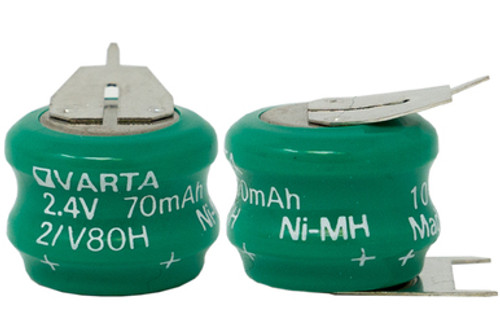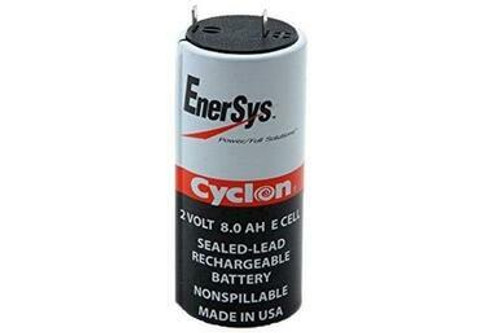2 - 2.4 Volt
-

2.4 Volt NiCd Battery Pack (700 mAh)
$12.29As low as:- Buy in bulk and save
Bulk discount rates
Below are the available bulk discount rates for each individual item when you purchase a certain amount
- Buy 2 - 6 and pay only $12.29 each
- Buy 7 - 20 and pay only $11.09 each
- Buy 21 - 40 and pay only $10.39 each
- Buy 41 or above and pay only $10.39 each
-

2.4 Volt NiCd Battery Pack (1000 mAh)
$13.89As low as:- Buy in bulk and save
Bulk discount rates
Below are the available bulk discount rates for each individual item when you purchase a certain amount
- Buy 2 - 5 and pay only $13.89 each
- Buy 6 - 17 and pay only $12.49 each
- Buy 18 - 35 and pay only $11.79 each
- Buy 36 or above and pay only $11.79 each
-

2.4 Volt Sanyo (2N-650SC) NiCd Battery Pack (650 mAh)
$13.99As low as:- Buy in bulk and save
Bulk discount rates
Below are the available bulk discount rates for each individual item when you purchase a certain amount
- Buy 2 - 5 and pay only $13.99 each
- Buy 6 - 17 and pay only $12.59 each
- Buy 18 - 35 and pay only $11.89 each
- Buy 36 or above and pay only $11.89 each
-

-

Varta 2/V80H 3P 2.4 Volt 3 Pin NiMH Battery
$16.39As low as:- Buy in bulk and save
Bulk discount rates
Below are the available bulk discount rates for each individual item when you purchase a certain amount
- Buy 2 - 7 and pay only $16.39 each
- Buy 8 - 15 and pay only $15.89 each
- Buy 16 - 30 and pay only $15.59 each
- Buy 31 - 61 and pay only $14.69 each
- Buy 62 or above and pay only $14.69 each
-

2.4 Volt NiMH Battery Pack (2200 mAh)
$17.39As low as:- Buy in bulk and save
Bulk discount rates
Below are the available bulk discount rates for each individual item when you purchase a certain amount
- Buy 2 - 4 and pay only $17.39 each
- Buy 5 - 14 and pay only $15.59 each
- Buy 15 - 28 and pay only $14.79 each
- Buy 29 or above and pay only $14.79 each
-

2-Pack 2.4 Volt NiCd 600 mAh (6392 UN) Cordless Phone Batteries
$17.69As low as:- Buy in bulk and save
Bulk discount rates
Below are the available bulk discount rates for each individual item when you purchase a certain amount
- Buy 2 - 4 and pay only $17.69 each
- Buy 5 - 28 and pay only $15.89 each
- Buy 29 or above and pay only $15.89 each
-

2-Pack 2.4 Volt NiCd 730 mAh (6393 UN) Cordless Phone Batteries
$17.69As low as:- Buy in bulk and save
Bulk discount rates
Below are the available bulk discount rates for each individual item when you purchase a certain amount
- Buy 2 - 2 and pay only $17.69 each
- Buy 3 - 99 and pay only $15.09 each
- Buy 100 or above and pay only $15.09 each
-

-

Varta 2/V150H 2.4 Volt 3 Pin NiMH Battery
$19.99As low as:- Buy in bulk and save
Bulk discount rates
Below are the available bulk discount rates for each individual item when you purchase a certain amount
- Buy 2 - 6 and pay only $19.99 each
- Buy 7 - 12 and pay only $19.39 each
- Buy 13 - 25 and pay only $18.99 each
- Buy 26 - 50 and pay only $17.99 each
- Buy 51 or above and pay only $17.99 each
-

Panasonic CTL1616F 2.3 Volt Lithium Ion Coin Cell Battery
As low as:- Buy in bulk and save
Bulk discount rates
Below are the available bulk discount rates for each individual item when you purchase a certain amount
- Buy 2 - 4 and pay only $20.99 each
- Buy 5 - 35 and pay only $18.89 each
- Buy 36 or above and pay only $18.89 each
-

-

-

-

Welch Allyn 72000 Replacement 2.4 Volt NiCd Medical Batteries for Welch Allyn Otoscope Handles
$32.99As low as:- Buy in bulk and save
Bulk discount rates
Below are the available bulk discount rates for each individual item when you purchase a certain amount
- Buy 2 - 6 and pay only $32.99 each
- Buy 7 - 17 and pay only $32.99 each
- Buy 18 - 25 and pay only $29.19 each
- Buy 26 or above and pay only $29.19 each
-

-

10-Pack 2.4 Volt Sanyo (2N-650SC) NiCd Battery Pack (650 mAh)
$59.99As low as:- Buy in bulk and save
Bulk discount rates
Below are the available bulk discount rates for each individual item when you purchase a certain amount
- Buy 2 - 5 and pay only $13.99 each
- Buy 6 - 17 and pay only $12.59 each
- Buy 18 - 35 and pay only $11.89 each
- Buy 36 or above and pay only $11.89 each
-

-

Batteries are indispensable power sources that cater to a vast array of applications, from industrial systems to consumer electronics. Among the many types of batteries available, 2-Volt and 2.4-Volt batteries stand out for their unique characteristics and use cases. Each voltage type is tailored to specific needs, offering varying capacities, sizes, and benefits.
2-Volt Batteries
A 2-Volt battery is a rechargeable power source commonly utilizing lead-acid chemistry. These batteries are robust, durable, and designed for high-capacity applications, making them a staple in industrial and energy storage systems.
Key Applications
2-Volt batteries are frequently used in:
Telecommunications Equipment: Serving as backup power sources for uninterrupted communication.
Uninterruptible Power Supplies (UPS): Ensuring critical devices remain powered during outages.
Solar Energy Systems: Storing energy generated by solar panels for later use.
Industrial Backup Power: Supporting critical operations in factories and data centers.
Benefits of 2-Volt Batteries
High Capacity:
2-Volt batteries are designed to store significant amounts of energy, making them ideal for applications requiring extended power reserves.
Longevity:
These batteries offer a longer lifespan than many other types, often lasting several years with proper maintenance.
Their durability makes them cost-effective for long-term use.
Reliability:
2-Volt batteries are known for their consistent performance, even under demanding conditions.
They can handle deep discharge cycles, making them suitable for applications where power outages are frequent.
Compatibility with Energy Storage Systems:
Due to their robustness, 2-Volt batteries are often integrated into renewable energy setups, such as solar and wind power systems.
Limitations
Size and Weight: Due to their high capacity, 2-Volt batteries are often larger and heavier than other types, making them less suitable for portable applications.
Maintenance Requirements: Lead-acid batteries require regular maintenance, including checking electrolyte levels and ensuring proper charging.
2.4-Volt Batteries
A 2.4-Volt battery is a rechargeable power source commonly built with Nickel-Metal Hydride (NiMH) or Nickel-Cadmium (NiCd) chemistry. These batteries are smaller and lighter than 2-Volt batteries, making them ideal for portable devices and compact applications.
Key Applications
2.4-Volt batteries are used in:
Consumer Electronics:
Cordless phones
Digital cameras
Remote controls
Backup Power:
Supporting smaller devices like alarms and home automation systems.
Portable Medical Devices: Powering tools that require compact and reliable energy sources.
Benefits of 2.4-Volt Batteries
Compact and Lightweight:
2.4-Volt batteries are designed for portability, making them an excellent choice for consumer electronics and handheld devices.
Rechargeable and Cost-Effective:
These batteries can be recharged hundreds of times, reducing the need for disposable replacements and lowering long-term costs.
Versatility:
Available in various configurations, 2.4-Volt batteries are suitable for a wide range of devices, from everyday gadgets to specialized tools.
Environmental Benefits:
Rechargeable batteries reduce waste compared to disposable options, contributing to sustainability.
Faster Charging (NiCd):
Nickel-Cadmium versions of 2.4-Volt batteries offer quicker recharge times, making them convenient for high-demand applications.
Limitations
Lower Capacity:
Compared to 2-Volt batteries, 2.4-Volt options generally have lower energy storage, limiting their use in high-capacity applications.
Memory Effect (NiCd):
NiCd batteries can suffer from the memory effect, requiring full discharge before recharging to maintain optimal capacity.
Choosing the Right Battery for Your Needs
When selecting between 2-Volt and 2.4-Volt batteries, consider the following factors:
Application:
For high-capacity, industrial, or backup power systems, 2-Volt batteries are ideal.
For portable, lightweight devices, 2.4-Volt batteries are a better fit.
Capacity Requirements:
If your device or system requires extended energy storage, opt for a 2-Volt battery.
For devices with moderate power demands, a 2.4-Volt battery will suffice.
Portability:
Choose 2.4-Volt batteries for portable devices where size and weight are important considerations.
Budget:
While 2-Volt batteries may have a higher upfront cost, their longevity can make them cost-effective over time.
2.4-Volt batteries offer affordability for smaller devices, with the added benefit of rechargeability.
Environmental Impact:
Rechargeable batteries, like 2.4-Volt NiMH options, are more eco-friendly than disposable alternatives or lead-acid batteries.
Maintenance Tips for 2-Volt and 2.4-Volt Batteries
To maximize the performance and lifespan of your batteries, follow these best practices:
Proper Storage:
Store batteries in a cool, dry place to prevent capacity loss or damage.
Regular Charging:
Avoid overcharging or undercharging your batteries, as this can reduce their lifespan.
Periodic Testing:
Check battery performance periodically, especially for critical applications like backup power systems.
Environmentally Responsible Disposal:
Recycle batteries at designated centers to minimize environmental impact and comply with local regulations.
Both 2-Volt and 2.4-Volt batteries offer unique advantages, making them suitable for different applications. 2-Volt batteries excel in industrial and backup power scenarios where high capacity and reliability are essential. In contrast, 2.4-Volt batteries shine in portable and consumer electronics, offering compact design and rechargeability.
By understanding the strengths and limitations of each type, you can select the battery that best meets your specific needs. Whether powering critical infrastructure or everyday devices, these batteries provide reliable energy solutions for a wide range of applications.





